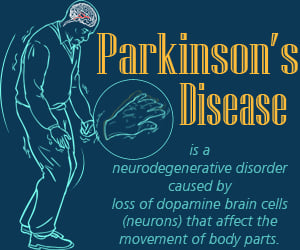Types of Surgery
The two surgical procedures employed in the treatment of Parkinson’s disease are lesioning and deep brain stimulation
There are two surgical procedures - lesioning and deep brain stimulation - and three target locations in PD surgery: Thalamus, Globus pallidum internus, and Subthalamic Nucleus.
1. Lesion procedures destroy areas of brain that maybe responsible for the symptoms. In this procedure a radio-frequency energy is delivered to heat and ablate (destroy) a pea-sized region within the brain,where there is abnormal activity related to the movement problems.
In a surgical technique called pallidotomy, an electric probe is employed to destroy a hyperactive small portion of the brain called Globus pallidus that is believed to generate the symptoms of Parkinson's disease.

A thalamotomy on the other hand is the removal of the thalamus region of the brain which is responsible for involuntary movements. This type of surgery is a rarity and is usually employed as a last resort for patients whose disease is debilitating. However, the procedure does not help to alleviate other symptoms of Parkinson's disease.
2. Deep brain stimulation (DBS) is a novel alternative surgical technique and uses implanted electrodes to stimulate minute regions of the brain. These electrodes blocks the brain waves that creates uncontrollable movements creating the same effect as a lesion but without destroying the region of the brain.
The effect lasts as long as the stimulation continues, but ceases when it is shut off. This procedure must be continued lifelong. It is especially useful in patients that have severe symptoms such as tremor, involuntary movements (dyskinesia), and problems with gait.
Neurostimulators
A battery-operated pacemaker-like device that contains a microelectronic circuitry for controlled electrical pulse generation. The neurostimulator is implanted subcutaneously near the clavicle. It generates electrical signals that are delivered by the extension and lead(s) to the targeted structures deep within the brain.
Kinetra Dual channel Neurostimulator
The Kinetra® dual-channel neurostimulator accommodates two extensions/leads, and thus provides bilateral neurostimulation from a single neurostimulator. The Kinetra neurostimulator is 61 mm x 76 mm x 13 mm and weighs 83 grams.
DBS Lead:
Four thin, insulated, coiled wires bundled within polyurethane insulation. Each wire ends in a 1.5 mm electrode, resulting in four electrodes at the tip of the lead. The DBS Lead delivers stimulation using either one electrode or a combination of electrodes.
Therapy Controllers
A patient places the compact, handheld therapy controller over the neurostimulator and presses buttons to turn one or both of the neurostimulators ON and OFF, to view the system's ON/OFF status, and to check the system's battery status.
Patients with a Kinetra® neurostimulator may use the Access® Therapy Controller, which allows them limited control over stimulation parameters within a physician’s prescribed limits.
Graphic Model-Stereotactic Brain Surgery
During needle-guided (stereotactic) brain surgery, the patient remains awake. This is for two reasons.
- The first is that the brain itself has no pain sensors, and once the initial incision is made (using a local anesthetic like Novocain), there is no pain.
- The second is that patient must be able to respond to the surgical team's questions about what he is experiencing during the surgical procedure. The pathway to the target lies close to several other important structures in the brain that may be inadvertently stimulated during the procedure. This may cause unusual sensations such as flashing lights, tingling, or experience of emotions. The patient then reports these sensations to the surgeon during the procedure. Avoiding these areas is crucial for a successful surgery.
As surgery requires very precise placement of surgical instruments, a three-dimensional frame is attached to the patient's head to guide the surgeon. The frame may be uncomfortable and local anesthetics maybe used to ease the discomfort. Before surgery, patients will also undergo several imaging procedures, in order to identify the target and other landmarks within the brain. Depending on the center, the procedures may include Magnetic Resonance Imaging (MRI) scans, Computerized Tomography (CT), or ventriculography.








